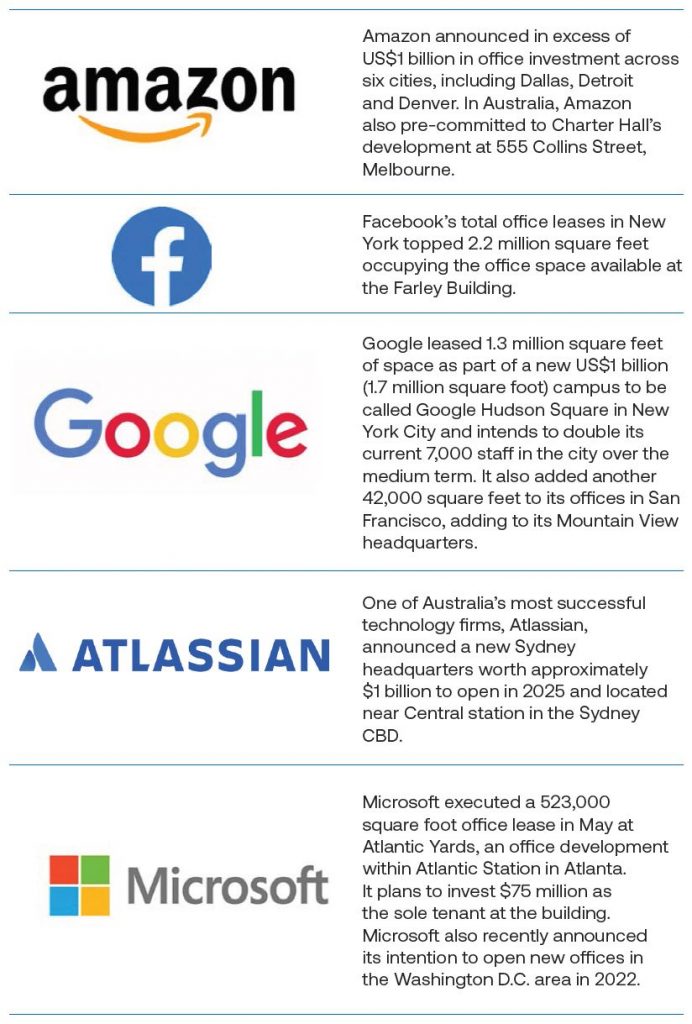

The rise of technology
Over the past two decades, the substitution between the traditional office and remote working or work from home (WFH) arrangements has been possible because of the steady progressive advancement of communicative technologies.
The global lockdown forced the accelerated adoption of these technologies, which prompted further advancement of platforms such as Microsoft Teams, Zoom, GoToMeeting, and Webex. It also simultaneously shifted perspectives on working away from the traditional office, as many people were forced to experience working from home first hand.
With improved technology, shifting perspectives, and the prospect of a post-COVID world with the vaccine roll out, we can now explore the potential impact on the demand for office space.
Office work
The key benefits to functional offices are well understood. At its foundation, a quality office provides an environment which incubates, facilitates and promotes productivity, collaboration, culture and success.
Corporations across most industries work in offices, including some of the fastest growing corporations – technology firms.
Technology firms and office work
Over the past year the world’s largest technology companies recorded significant growth in revenue and the demand for their products. The pandemic advanced remote working technologies and accelerated other digital trends, such as payments to online retailing. Interestingly, over this period some of these global technology leaders also made decisions regarding their office workplace strategies.

Microsoft in focus
Microsoft has been one of the largest beneficiaries from the shift to WFH routines. Amongst its suite of communication software like Outlook (email) and other technologies offered by the Office suite, the adoption of Microsoft Teams and Windows Virtual Desktop grew significantly.
Microsoft’s cloud-computing service Azure, its gaming systems, and Windows have also recorded rapid growth amid the WFH shift. With this rapid product growth, Microsoft has invested in research to better understand WFH technologies and their impact on workers.
Microsoft’s latest Work Index Trend study was centred around the finding: Brainwaves reveal remote meeting fatigue is real.1 The following sections are extracted from the report.
“More remote work can lead to elongated working hours, meeting fatigue, and missed in-person connections like spontaneous hallway conversations that can bond a team and make collaboration feel easier. And the lack of connected and comfortable home workspaces remains a productivity challenge for most of us.
The study found that remote collaboration is more mentally challenging than in-person collaboration. Specifically, brainwave patterns associated with stress and overwork were much higher when collaborating remotely than in-person. But they found something unexpected as well: If the pair first worked together remotely, their brainwaves suggested it was more difficult for them to work together in-person afterwards. It seems that the social connection and work strategies created when working in-person transfers to a remote setting, but the opposite is untrue.
A second study found that brainwave markers associated with overwork and stress are significantly higher in video meetings than non-meeting work like writing emails. Further, due to high levels of sustained concentration, fatigue begins to set in 30-40 minutes into a meeting. Looking at days filled with video meetings, stress begins to set in at about two hours into the day. The research suggests several factors lead to this sense of meeting fatigue: having to focus continuously on the screen to extract relevant information and stay engaged; reduced non-verbal cues that help you read the room or know whose turn it is to talk; and screen sharing with very little view of the people you are interacting with.”
Three other major findings were published, based on analysis of users of Microsoft’s ‘Teams’ product, that many companies, including Charter Hall – use for online and virtual meetings.
“1. The pandemic will have a lasting impact on work
One of the most consistent themes was that this unique circumstance has accelerated the blending of work and life – which could soften dynamics of the workplace forever. Over half of the parents surveyed (54%) said it’s been difficult balancing household demands while WFH. This burden was felt most heavily by millennials as well as new entrants to the workforce, Generation Z. This may be because this group is more likely tasked with caring for younger children or sharing workspaces with roommates while managing a full-time job.
2. The 9 to 5 workday may be fading away
The average time between Microsoft customer’s first and last use of Teams had increased by over one hour. In this report, we explore this concept further – is the 9 to 5, five-day workweek still disappearing? The data suggests, yes. In Teams, people are working more frequently in the morning and evening hours, but also on the weekends. Teams chats outside of the typical workday, from 8-9 a.m. and 6-8 p.m., have increased more than any other time during the day – between 15% and 23%. Weekend work is spiking as well – Teams chats on and Saturday and Sunday have increased over 200%.
3. Physical offices will not disappear in the future of work
Many workers around the world have spent the last four months working remotely at least part-time. As teams have adjusted to this new reality, many are wondering – will physical offices disappear in the future of work? Microsoft research indicates that work will likely be a fluid mix of in-person and remote collaboration.
Still, several pain points associated with working from home were uncovered. Nearly 60% of people surveyed feel less connected to their colleagues since working remotely more often. In China, this number spiked to 70%.
In addition, only 35% of respondents in one study2 have a dedicated home office. And only 5% of the people surveyed in the Harris Poll live alone. So it’s no surprise that distractions, connection issues, and lack of ergonomic work environments were noted throughout the research as some of the top pain points of remote work. This indicates that while the future of work will be more remote than before, the physical office space – which brings benefits like connected, ergonomic workspaces and opportunities for social connecting and team bonding – will likely remain a core part of the future of work.
For instance, 82% of managers surveyed expect to have more flexible work from home policies post-pandemic.”
The Charter Hall view
These findings appear to be consistent with a vast majority of workplace studies that we have seen. Put simply, employees value WFH flexibility but they also enjoy – and benefit from – the office environment. Some organisations will need to adjust their workplace strategies to provide greater flexibility. However, many firms were already on this path.
Our tenants are telling us that office work will remain essential in stimulating productivity, growth, maintaining culture, managing risk and driving innovation.
The onus is on corporate landlords and occupiers to ensure that the workplace environment remains a compelling proposition through provision of a high level of amenity and facilities to ensure that the office is an enjoyable, meaningful and productive experience.
To find out more visit: www.charterhall.com.au/direct
1. The full study can be found at: https://www.microsoft.com/en-us/microsoft-365/blog/2020/07/08/future-work-good-challenging-unknown/.
2. An ongoing study conducted by Microsoft found that during the screening process 35.3% of full- time information workers (N=570) work remotely in a dedicated home office.
This article is sponsored content. The supplier of this content has a commercial arrangement with Switzer Financial Group.